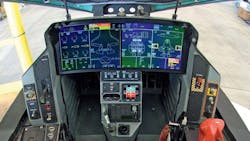Air Force seeks to integrate existing sensors to help monitor pilot health in the jet aircraft cockpit
WRIGHT-PATTERSON AFB, Ohio – U.S. Air Force researchers are approaching industry new kinds of cockpit sensors to monitor and alert pilots to problems with their abilities to function and behave normally during flight in high-performance aircraft.
Officials of the Air Force Research Laboratory at Wright-Patterson Air Force Base, Ohio, issued a request for information (AFRL-711-RHX-002) last week for a project to develop airman-centric sensors to help sustain and enhance pilot performance.
The Airman Bioengineering Division of the lab's 711th Human Performance Wing's Airman Systems Directorate is looking for performance-enhancing sensor systems for the cockpit.
Researchers are looking for companies to develop and demonstrate existing sensor technologies to help keep pilots working and feeling well in the cockpit. They are looking for self-contained and self-powered sensor hardware that is small enough to fit into aircraft cockpits.
Technologies of interest for monitoring pilot health include small-form-factor computing like smartphones and tablet computers, with low-energy BlueTooth wireless connectivity. The Air Force will provide the software, specifically the Cognitive Operations Gear (COG) Pack architecture. The COG Pack is government open-architecture software that gathers, stores, processes, publishes, and retransmit data from several sensors.
For the pilots, Air Force researchers are interested in monitoring air-quality; pilot vital signs; cockpit conditions like cabin pressure, temperature, and acceleration; and pilot breathing.
Researchers want systems with sufficient space and computing power for nine-to-12-hour flights. After the flight, gathered data should offload into a repository for long-term retention.
Systems should have onboard analytics that can generate parameters, apply decision rules or algorithms, and generate alerts to the pilot, and recommended corrective action. Pilot alerts should be easily perceptible and interpretable, with multimodal alerting ensure that the pilot gets the message.
From industry, the Air Force wants recommendations on technologies, technical feasibility, performance, resource availability, and costs.
Companies interested should email 10-page white papers no later than 3 Jan. 2020 to the Air Force's James Christensen at [email protected], with a copy to Joseph Mizzi at [email protected].
For questions or concerns contact the Air Force's Joseph Mizzi by email at [email protected] or by phone at 937-713-9925, or James Christensen by email at [email protected] or by phone at 312-794-9551.
More information is online athttps://www.fbo.gov/spg/USAF/AFMC/AFRLWRS/AFRL-711-RHX-002/listing.html.

John Keller | Editor-in-Chief
John Keller is the Editor-in-Chief, Military & Aerospace Electronics Magazine--provides extensive coverage and analysis of enabling electronics and optoelectronic technologies in military, space and commercial aviation applications. John has been a member of the Military & Aerospace Electronics staff since 1989 and chief editor since 1995.

